ABSTRACT
In Taiwan, strawberries (Fragaria ×ananassa Duch.) are an exotic and expensive commodity, with the retail market prices ranging from 170 to 670 NT$/kg (5.37 to 21.15 US$ based on the yearly average currency exchange rate in 2017). Because of the humid subtropical climate and lack of suitable cultivars, yields are relatively low with a narrow harvest window compared to major strawberry producing countries. However, consumer demand for strawberries is strong in Taiwan. Over the last two decades, there were significant changes in Taiwan’s strawberry industry. From 1997 to 2017, production area, production volume, yield, farm gate price, and production value increased by 36% (369 vs. 500 ha), 100% (4444 vs. 8907 t), 48% (12.0 vs. 17.8 t/ha), 94% (66 vs. 127 NT$/kg), and 186% (0.79 vs. 2.27 million NT$/ha), respectively. Strawberries produced in 2017 were valued at 1.13 billion NT$ (35.7 million US$), which was the highest on record. Imports of strawberries also increased by 104% (562 vs. 933 t) from 2006 to 2017. The industry’s rapid growth has been supported by advanced production technologies, improved crop management practices, breeding programs, and local marketing efforts. Taiwanese consumers are brand-conscious and demand for high-quality food products. Agritourism has recently become very popular in the strawberry production areas. Because of strong consumer demand and unique market opportunities, Taiwan’s strawberry industry has significant growth potential, particularly in U-pick and organic farming. This paper provides an overview of Taiwan’s strawberry industry and discusses its challenges and opportunities.
Introduction
Strawberry production in Taiwan has relatively low yields with a narrow harvest window compared to major strawberry-producing countries. Most production challenges are associated with the humid subtropical climate and lack of suitable cultivars (Luo, Citation2012a). On the other hand, consumer demand for strawberries is strong in Taiwan, as indicated by recent rapid increases in the domestic supply, farm gate prices, and imports (Agriculture and Food Agency, Citation2019; Customs Administration, Citation2017). To overcome production challenges, efforts have been made by growers and researchers to adopt optimum crop management practices and advanced production technologies, while selecting and developing improved cultivars. Considering that Taiwan has one of the world’s highest per capita consumption rates of fresh fruit (Chang, Citation2016), Taiwan’s strawberry industry has significant growth potential. There are also unique market opportunities because Taiwanese consumers are brand-conscious and demand for high-quality food products. This paper has two components. First, it provides an overview of Taiwan’s strawberry industry, including production history and trends, climates, cultivars, crop management, and marketing. Second, it highlights challenges and opportunities for this growing industry.
Production History and Trends
Strawberries were first introduced to Taiwan from Japan in 1934 (Luo, Citation2012a), but their commercial production did not start until 1958 (Liu, Citation1998; Luo, Citation2012a). Initially, most strawberry production was for processing, and many growers were contracted with jam manufacturers (Chu, Citation2007). Since 1980, fresh-market strawberry production rapidly expanded as U-pick strawberries gained popularity (Luo, Citation2012a). In 1985, ‘Toyonoka,’ a Japanese cultivar released in 1984, was introduced to Taiwan (Luo, Citation2012a). To date, this cultivar has been predominating the domestic market because of its more favorable aroma, taste, and shelf life than other cultivars (Luo, Citation2012a).
Strawberries are currently grown in Hsinchu, Miaoli, Nantou, and Taichung counties located in northern and central Taiwan (Luo, Citation2012a). These production areas have humid subtropical climates characterized by year-round high relative humidity and temperature, with a rainy season from May to September and a relatively dry period from October to April (). Among these production areas, Dahu Township (24.4°N, 120.8°E) in Miaoli County has the most favorable conditions for growing strawberries because of high elevations (300 to 700 m), which create cool weather during winter. With 375 hectares, Dahu Township accounts for about 75% of Taiwan’s strawberry industry, measured by both area under cultivation and production (Agriculture and Food Agency, Citation2017). Because of excessively high temperature and precipitation during the rainy season, the strawberry harvest window in Taiwan is limited to 6 months between November and April.
Figure 1. Monthly average temperature and rainfall in Dahu Township, Taiwan, 1997–2017. Source: Central Weather Bureau (Citation2019)
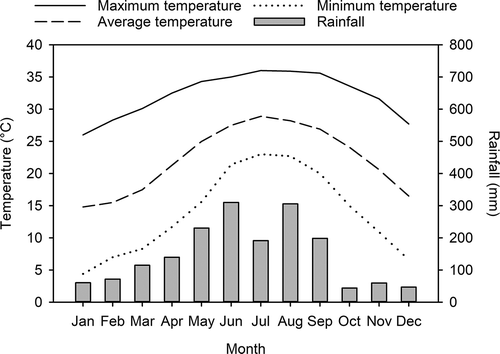
The area of strawberry production in Taiwan increased by 64% (369 vs. 604 ha) from 1997 to 2006 (). This increase was driven mostly by the rapid economic growth and increased consumer demand for fresh-market strawberries. From 2006 to 2017, however, production area decreased gradually in part because of aging of growers and lack of successors. The strawberry production area in 2017 was 500 ha, which is 36% higher than that in 1997 but 17% lower than the peak in 2006.
Figure 2. Strawberry production area in Taiwan, 1997–2017. Source: Agriculture and Food Agency (Citation2017)

Other strawberry production data showed steady increases over the last two decades (). From 1997 to 2017, strawberry production, yield, farm gate price, and production value increased by 100% (4444 vs. 8907 t, ), 48% (12.0 vs. 17.8 t/ha, ), 94% (65 vs. 127 NT$/kg, ), and 186% (0.79 vs. 2.27 million NT$/ha, ), respectively. In 2017, Taiwan produced 8907 tons of strawberries (), valued at 1.13 billion NT$ (35.7 million US$ based on the yearly average currency exchange rate in 2017: 1 US$ = 31.68 NT$) (Internal Revenue Service, Citation2019), which was the highest on record. These increases were due to improved cultivars, advanced production methods, increased popularity of agritourism, and increased consumer demand (Chu, Citation2007; Luo, Citation2012b; Tsai et al., Citation2009).
Figure 3. Strawberry yields and production volumes in Taiwan, 1997–2017. Source: Agriculture and Food Agency (Citation2017)
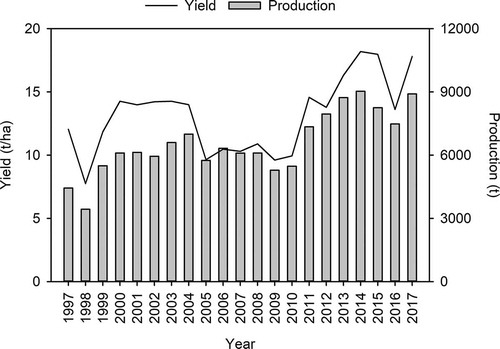
Figure 4. Strawberry production values and farm gate prices in Taiwan, 1997–2017. Yearly average currency exchange rate in 2017: 1 US$ = 31.68 NT$ (Internal Revenue Service, Citation2019). Source: Agriculture and Food Agency (2017, 2019)

The cost of strawberry production increased gradually from 0.79 million NT$/ha in 2004 to 1.10 million NT$/ha in 2015 (). The gross profit remained relatively constant from 2004 to 2009 (1.31 to 1.42 million NT$/ha), but it increased by 56% from 2009 to 2015 (1.42 vs. 2.22 million NT$/ha). This gross profit increase is due to increases in both strawberry yield and farm gate price. According to the National Statistics (Citation2015), number of strawberry farms was 1286, and the average farm size was 0.36 ha in 2015 ().
Table 1. Number of farms, production area, and average farm size for conventional and organic strawberry production systems in Taiwan, 2015a.
Figure 5. Strawberry production costs and profits in Taiwan, 2004–2015. Yearly average currency exchange rate in 2015: 1 US$ = 33.09 NT$ (Internal Revenue Service, Citation2019). Source: Agriculture and Food Agency (Citation2016)

Cultivars
Since the introduction of ‘Toyonoka’ in 1985, four cultivars have been developed by the Taoyuan District Agricultural Research and Extension Station, and a new cultivar was released by the Miaoli District Agricultural Research and Extension Station in 2019. Over the past decades, ‘Toyonoka’ was the most popular cultivar because of its superior fruit quality and shelf life compared to locally developed cultivars (Liu, Citation1998). Recently, poor disease resistance of ‘Toyonoka’ resulted in a downward trend in its production, leading to the increased production of new locally developed cultivars.
‘Toyonoka’ is a Japanese cultivar that was introduced in Taiwan in 1985 (Chu, Citation2007; Liu, Citation1998). This cultivar produces large berries with good shelf life and superior fruit quality characterized by a strong aroma and high sugar content (Lee, Citation2003). Compared to previously developed Japanese cultivars, ‘Toyonoka’ is more adaptable to warm temperate climates.
‘Taoyuan No. 1’ was selected from ‘Toyonoka’ plants for superior overall performance and propagated clonally. Therefore, ‘Taoyuan No. 1’ is not genetically different from ‘Toyonoka.’ It was registered as a cultivar in 1990 (Lee, Citation2003). ‘Taoyuan No. 1’ produces firmer berries than ‘Harunoka,’ a main Japanese cultivar before the introduction of ‘Toyonoka,’ and its aroma is rated higher than other imported cultivars (Chang, Citation2011). Compared to other newly released cultivars in Taiwan, it has higher yields (24.2–33.7 t/ha) and sweetness (8.1–10.3 °Brix) (Lee and Lee, Citation1999; Lee et al., Citation1993). However, it has been identified that ‘Taoyuan No. 1’ is highly sensitive to many diseases and pests, including anthracnose, phytophthora blight, gray mold rot, powdery mildew, foliar nematodes, two-spotted mites, and thrips (Lee and Lee, Citation1999).
‘Taoyuan No. 2’ was originated from a cross between ‘Sequoia’ and ‘Kunowase’ made in 1986, and it was officially released by the Taoyuan District Agricultural Research and Extension Station in 1993 (Lee et al., Citation1993). ‘Taoyuan No. 2’ develops shorter pedicels with an open canopy than ‘Taoyuan No. 1’. Compared to ‘Toyonoka,’ it produces larger berries and greater early yields, but it was not widely accepted by growers because of softer berries with a lower sugar content.
‘Taoyuan No.3’ was selected from a population of open-pollinated ‘Taoyuan No.1’ plants in 1988, with the goal of improving shelf life and fruit size, especially in the late harvest season (Lee and Lee, Citation1999). It was registered as a cultivar in 1998. ‘Taoyuan No. 3’ is recommended for U-pick operations because of its larger berries and slightly higher yield compared to ‘Taoyuan No. 1’ and ‘Taoyuan No. 2’ (Lee and Lee, Citation1999). It is more tolerant to anthracnose, phytophthora blight, powdery mildew, and two-spotted mites than ‘Taoyuan No. 1’ (Lee and Lee, Citation1999). However, some U-pick growers consider ‘Taoyuan No. 3’ unattractive to consumers because of its poor flavor. ‘Taoyuan No. 3’ is currently grown by only a few growers.
‘Taoyuan No. 4’ was developed from a cross between ‘TYS80-25’ and ‘Taoyuan No. 3’ in 2003 to improve the postharvest fruit quality of ‘Taoyuan No. 3’ (Luo et al., Citation2012). Compared to ‘Taoyuan No.1’ and ‘Taoyuan No.3’, ‘Taoyuan No. 4’ has larger berries and produces almost twice the yield. However, it produces a high percentage of misshapen and fibrous berries with relatively low sweetness. Only a few U-pick growers currently grow this cultivar. It is unlikely that ‘Taoyuan No. 4’ will replace ‘Toyonoka’ or ‘Taoyuan No.1’.
‘Miaoli No.1’ is a new cultivar released in 2019. It was developed from a cross between ‘Taoyuan No. 1’ and one of the breeding lines at the Miaoli District Agricultural Research and Extension Station, MLSBL, in 2014 to improve the disease resistance of ‘Taoyuan No. 1’ (Wu et al., Citation2019). Compared with ‘Taoyuan No. 1’, ‘Miaoli No.1’ has larger fruit size (20.5 vs. 14.2 g/berry) and higher °Brix (16.5 vs. 10.7). It greatly adapts to subtropical climates in Taiwan, showing high runner propagation rates and improved yields (347 g/plant).
Some experienced strawberry growers select plants with superior yields and fruit quality based on field observations and propagate them for the next growing season. As a result, some unique selections have been made by local growers, such as ‘Aroma’ and ‘Apple,’ which were so named because of the aroma characteristics. However, their pedigrees are completely unknown.
In Miaoli County, ‘Toyonoka’ and ‘Aroma’ are two major cultivars for commercial production; however, for the past 2 years, there is a trend for increased production of ‘Aroma’ because of its enhanced disease resistance to anthracnose compared with ‘Toyonoka.’ From 2014 to 2019, the planting of ‘Aroma’ increased from 20% to 70% of the total production area in Miaoli County (You, Citation2019).
Production Systems and Practices
Production Systems
Strawberries are grown as an annual crop in Taiwan. Most strawberry production occurs at small family-run operations. Strawberries are produced primarily in open fields (), but strawberry production under protected culture has been increasing in recent years (). In open fields, strawberries are grown on raised beds with plasticulture (Luo, Citation2012c; ). Plug transplants () are more commonly used than bare-root transplants. Transplants are planted in the field from late-September to early-October. To avoid excess heat accumulation during establishment, growers install white-on-black or silver-on-black plastic mulch before planting, or install black plastic mulch at 30 to 40 days after planting (Chu, Citation2007; Luo, Citation2012c). Strawberry harvesting begins in mid-November and typically ends in April (Li, Citation2011; Liu, Citation1998). Some growers grow cover crops and vegetables during the off-season (Li, Citation2011).
Figure 6. Strawberry production systems in Taiwan: (a) open-field production, and (b) greenhouse production

Figure 7. Strawberry plug transplants commonly used by commercial growers in Taiwan: (a) transplants grown in Jiffy peat pellets, and (b) a transplant grown in a thin wall plastic tube (4 cm diameter × 12 cm tall). Photo credit: Chia-Bin Lyu
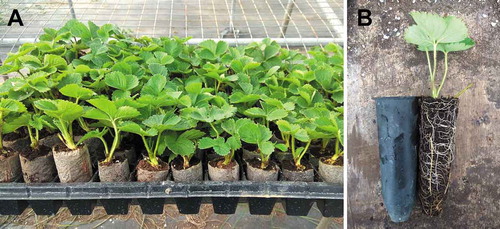
In 2015, strawberries were produced organically on 21 hectares at 108 farms, accounting for 4.5% of strawberry production area or 8.4% of strawberry farms in Taiwan (). The average farm size of organic farms was 50% (0.38 vs. 0.19 ha) of conventional farms.
Bed Preparation
Because of typhoons and heavy rainfall during the establishment, raised beds are important to improve soil drainage. Raised beds are prepared between late-August and early-September (Li, Citation2011). Typical bed width and height are 80 to 90 cm and 30 to 40 cm, respectively (Luo, Citation2012c). Beds are spaced 1.2 m apart. Each bed has two staggered plant rows that are spaced 27 to 30 cm apart. In-row plant spacing is 20 to 35 cm. Thus, plant density ranges from 40000 to 50000 plants/ha. Fumigation is barely used in Taiwan.
Soil and Fertilization
The soil in northern Taiwan including the major strawberry production area is classified as an ultisol (Chen et al., Citation2015). According to the soil analysis performed for 48 strawberry farms in Dahu Township, 60% of farms had soil pH below 5.0 and organic matter below 1.5% (Chang and Wu, Citation2015). Because of the poor soil fertility, incorporation of compost at 10 tons per hectare is recommended. Current fertilization recommendations are 150 to 200 kg of nitrogen (N), 65 to 87 kg of phosphorus (P), and 125 to 166 kg of potassium (K) per hectare for the growing season (Chuang, Citation2012). During the establishment, compound fertilizers (e.g. 15N–6.6P–12.5K–2.4Mg) are recommended to be broadcasted at 100 to 130 kg of N per hectare. At 30 to 45 days after planting, application of additional 50 to 70 kg of N per hectare is recommended via top-dress application of the same fertilizer. Over-fertilization is frequently observed in Dahu Township (Chang and Wu, Citation2015).
Transplant Propagation
Many strawberry growers propagate transplants by themselves with runners to reduce production costs, although some growers purchase plug transplants from commercial nurseries (Chu, Citation2007). Commercial plug transplants are uniform and high quality, which are typically grown in Jiffy peat pellets (Jiffy International AS, Kristiansand, Norway) () or using thin wall plastic tubes (4 cm diameter × 12 cm tall) (). Growers select strong mother plants that survive through the end of harvest season and transplant those plants to raised beds. In summer, growers plant runners in plastic tubes or pots packed with soilless media. Bare-root transplants propagated by nurseries in highlands are also available, although they are used less commonly compared to plug transplants.
Irrigation
Groundwater is a common source of irrigation water. In general, furrow irrigation is used during plant establishment in mid-September, and drip irrigation is used after establishment (Chu, Citation2007; Luo, Citation2012c). One drip tape is installed between two plant rows in each bed (Luo, Citation2012c).
Diseases and Pests
Gray mold rot (Botrytis cinerea), fruit rot (Phytophthora cactorum and P. citrophthora), powdery mildew (Sphaerotheca macularis f. sp. fragariae) and anthracnose (Colletotrichum gloeosporioides) are major diseases, and two-spotted spider mite (Tetranychus urticae Koch) and tobacco cutworm (Spodoptera litura Fabricius) are major arthropod pests (Chuang et al., Citation2012; Shih et al., Citation2009; Tsai et al., Citation2009; Wu, Citation2012)
Marketing
Before ‘Toyonoka’ was introduced in Taiwan, most strawberries were used only for processing. Nowadays, most strawberries are produced for fresh market sales. Strawberries are used for processing only in oversupply situations or when they do not meet the cosmetic quality standards.
U-pick strawberry operations (a&b) started in 1978 and have been growing until now because of high profitability. In a non-organic U-pick operation, the recreation value per visitor is about 80 US$ whereas it is expected to increase to 103 US$ for an organic U-pick operation in Dahu Township (Chiueh and Huang, Citation2011). U-pick strawberries are now available in most strawberry-producing counties, although Dahu Township is the most popular tourist destination known as “Kingdom of Strawberries” (Hu et al., Citation2010; Liu, Citation1998). In 2014, the Strawberry Cultural Center was opened in Dahu Township (). This agritourism facility includes a film viewing room, exhibitions of various specialty agricultural products, displays of strawberry ecology and history, gardens, restaurants, and giftshops. In addition to freshly picked strawberries, there are all kinds of processed products made with strawberries sold at restaurants and giftshops, including wines (), vinegar, sausages, cookies, and cakes (Huang, Citation2002; Pong, Citation2012). Many U-pick farms are located around the center. Growers use extra-high raised beds with plasticulture or vertical growing systems with soilless media to improve consumer experience with strawberry picking in open fields. There are also U-pick operations using table-top production systems in high tunnels or greenhouses. These local efforts by Miaoli County and the Dahu Farmers’ Association increased the popularity of picking strawberries as a recreational activity and supported the growth of the strawberry industry. In 2018, there were over 60 U-pick farms in Dahu Township, whereas there were only a few in other counties (Dahu Tourism, Citation2018).
Figure 8. Strawberry agritourism in Dahu Township, Miaoli County, Taiwan: (a) a conventional U-pick farm, (b) an organic U-pick farm, (c) the Dahu Strawberry Cultural Center, and (d) strawberry wines. Photo credit: Shih-Yi Yang, Ming-Hsuan Tsai, and Fa-Pin Chen
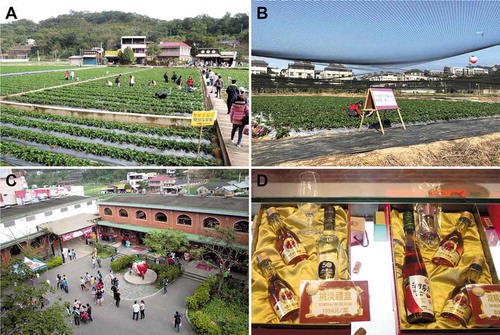
Strawberries are imported in Taiwan during summer, when the domestic supply is not available. The import volume of fresh strawberries was relatively constant from 2006 to 2014, ranging from 456 to 561 tons, but it increased rapidly thereafter (). In 2017, Taiwan imported 933 tons of fresh strawberries, which was 66% higher than the imports in 2006. The United States is the top exporting country accounting for 64% of strawberries imported into Taiwan in 2017, followed by New Zealand (18%), Japan (10%), and South Korea (8%) (Customs Administration, Citation2017). Imported strawberries are priced much higher than strawberries produced in Taiwan during winter. The average wholesale price of imported strawberries increased by 225% (161 vs. 523 NT$/kg) from 2006 to 2017 (Agriculture and Food Agency, Citation2019; ), recording the highest price in 2017 at 523 NT$/kg. Japanese high-quality strawberries are sold at high-end supermarkets, and they are typically purchased as a gift. Taiwan exports less than 100 tons of strawberries per year, mainly as processed products (Customs Administration, Citation2017).
Figure 9. Volumes and wholesale prices of imported strawberries in Taiwan, 2006–2017. Yearly average currency exchange rate in 2017: 1 US$ = 31.68 NT$ (Internal Revenue Service, Citation2019). Source: Agriculture and Food Agency (Citation2019); Customs Administration (Citation2017)
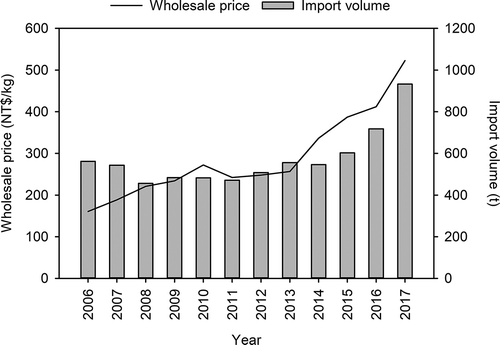
Challenges and Opportunities
Humid subtropical climates characterized by high relative humidity and temperature especially during the rainy season from May to September allow only a narrow harvest window, from November to April. Heat stress is a major factor limiting strawberry growth and production. During the establishment period from mid-September to early October, temperature often exceeds 30°C (), strongly inhibiting establishment growth and flower formation. Heat stress can also weaken defense mechanisms against diseases and insects (Lee et al., Citation2012). Temperature often exceeds 30°C also in April, during which time heat stress can negatively affect both yields and fruit quality (Kadir et al., Citation2006; Ledesma et al., Citation2008).
Anthracnose and two-spotted spider mites are also serious problems (Tsai et al., Citation2009). It is important to develop an integrated pest management program especially for organic U-pick operations, which are rapidly gaining popularity in Taiwan. It was reported that releasing a natural enemy, green lacewing [Mallada basalis (Walker)], is effective in controlling tetranychid mites on strawberry plants in the field (Chang and Huang, Citation1995). In recent years, the supply of ‘Toyonoka’ seedlings has been threatened by anthracnose, resulting in increased production of ‘Aroma,’ which has enhanced disease resistance compared to ‘Toyonoka.’
Strawberry production is currently predominated by just one Japanese cultivar, ‘Toyonoka,’ which was introduced in Taiwan in 1985. Although this cultivar has more favorable aroma and taste than other cultivars available in Taiwan, growers have been struggling with its low fruit yields because of heat stress and pest problems described above. The average strawberry yield in the last 10 years (from 2008 to 2017) in the United States and Taiwan were 52.9 and 14.3 t/ha, respectively. Florida is the largest strawberry-producing state in the United States during winter months, and it has very similar climatic conditions and harvest window to Taiwan. The average strawberry yield from 2008 to 2017 in Florida was 78% higher than that in Taiwan (14.3 vs. 25.5 t/ha) (Agriculture and Food Agency, Citation2017; USDA, Citation2018), demonstrating the low productivity of strawberries grown in Taiwan. This yield difference between Florida and Taiwan could be due to various factors including cultivars, crop management practices, grading standards, and pest problems. In Florida, seven cultivars have been developed by the University of Florida’s strawberry breeding program since 2000 (University of Florida, Citation2020; Whitaker et al., Citation2012). These cultivars are well adapted to Florida’s subtropical climate and other winter and early spring production regions, as indicated by the fact that they are currently grown in 36 countries (University of Florida, Citation2020).
Development of improved cultivars is an ideal solution to overcome the current production challenges described above, while meeting the high consumer demand for high-quality strawberries. However, poor availability in germplasm resources is the major limiting factor for local breeding programs. Although introducing new cultivars or germplasm resources developed in subtropical regions, such as Florida, would be beneficial to Taiwan’s strawberry industry and breeding programs, it is restricted by strict import regulations enforced by the Bureau of Animal and Plant Health Inspection and Quarantine. The import regulations require plant materials including tissue culture plants to be quarantined for at least 1 year (Bureau of Animal and Plant Health Inspection and Quarantine, Citation2018).
Outlook
Because of the difficulties in immediately developing or importing improved cultivars, selection of superior plants by local growers will remain an important strategy for Taiwan’s strawberry industry. Other important strategies include integrated pest management, advanced production technologies, optimized crop management practices, and high-quality seedling. Implementing innovative crop management strategies may also improve the performance of current strawberry cultivars in Taiwan. For example, recent studies reported that new reflective-striped plastic mulch films are highly effective in reducing heat stress during establishment and improving earliness of winter strawberry production in subtropical climates (Deschamps and Agehara, Citation2019; Deschamps et al., Citation2019).
Despite many production challenges, Taiwan’s strawberry industry has experienced significant growth in the last 20 years, driven by improved cultivars, advanced production methods, increased popularity of agritourism, and increased consumer demand. High profitability of strawberry production in Taiwan is currently supported by high farm gate prices. The limited domestic fruit production in winter may have driven increased consumer demand for strawberries. Furthermore, the peak harvest season of strawberries coincides with Lunar New Year. Because red is the color that represents happiness in Taiwanese culture, strawberries provide festive vibes, and Dahu Township has become a vibrant travel destination during Lunar New Year holidays. More than one million people visit Dahu Township during the strawberry season (Chiueh and Huang, Citation2011). Considering that Taiwan has one of the world’s highest per capita consumption rates of fresh fruit (Chang, Citation2016), Taiwan’s strawberry industry has significant growth potential.
It is expected that Taiwan’s strawberry industry, particularly U-pick and organic strawberry production, will continue to expand. Furthermore, recent advancements in production technologies and crop management practices may lessen production challenges associated with subtropical climatic conditions. To date, strawberry production is still relying primarily on scattered small farms. Implementing a traceability system and co-branding may be effective marketing strategies to promote value addition for locally grown strawberries.
References
- Agriculture and Food Agency. 2016. Agricultural production cost survey. Agriculture and Food Agency, Taipei, Taiwan. 5 Apr. 2019. <https://agrcost.afa.gov.tw/pagepub/AppInquiryPage.aspx>.
- Agriculture and Food Agency. 2017. Crops production within all Counties. Agriculture and Food Agency, Taipei, Taiwan. 20 Mar. 2019. <https://agr.afa.gov.tw/afa/afa_frame.jsp>.
- Agriculture and Food Agency. 2019. Fruit price and volume. Yi Chang Information SI Inc., Taipei, Taiwan. 20 Mar. 2019. <https://amis.afa.gov.tw/fruit/FruitChartProdTransPriceVolumeTrend.aspx>.
- Bureau of Animal and Plant Health Inspection and Quarantine. 2018. Plant protection and quarantine act. Bureau of Animal and Plant Health Inspection and Quarantine, Taipei, Taiwan. 25 Mar. 2019. <https://www.baphiq.gov.tw/files/web_articles_files/baphiq/9218/20992.pdf>.
- Central Weather Bureau. 2019. Observation website monthly data. Central Weather Bureau, Taipei, Taiwan. 20 Mar. 2019. <https://www.cwb.gov.tw/V7e/climate/agri/agri_month.htm>.
- Chang, C. 2016. Fresh deciduous fruit annual Taiwan’s apple imports forecast to decline slightly. U.S. Dept. Agr. Washington, D.C., The United States. 25 Mar. 2019. <https://gain.fas.usda.gov/RecentGAINPublications/FreshDeciduousFruitAnnual_Taipei_Taiwan_11-16-2016.pdf>.
- Chang, C.P., and S.C. Huang. 1995. Evaluation of the effectiveness of releasing green lacewing, Mallada basalis (Walker) for the control of tetranychid mites on strawberry. Plant Protect. Bul (Taipei) 37:41–58.
- Chang, G.M., and T.Y. Wu. 2015. Soil management practices in strawberry fields. Miaoli District Res. Nwsl 29:6–8. (In Chinese).
- Chang, S.J. 2011. Studies of breeding on strawberry. Miaoli District. Agricultural Res. Ext. Sta., COA, Taipei, Taiwan. 20 Mar. 2019. <https://www.mdais.gov.tw/redirect_files.php?link=bXQjeYM2d5WGSlasht3nWGPlusPbEmtWGSlash6vpgI6ZqrwWGEqualWGEqualWPBhiWGSlashspzENM005jTVCA7hSBnwTMBWzllwOEJG0CyKrxpbm18ThdayE&file_name=ilmzWGPlusnHWGSlashMeEVVtkWGEqual4yC3dFr3lULa7bAHrDhEPQvkWlWGPlusR>.
- Chen, Z.S., Z.Y. Hseu, and C.C. Tsai. 2015. Oxisols and ultisols, p. 95–108. In: Z.-S. Chen, Z.-Y. Hseu, and -C.-C. Tsai (eds.). The soils of Taiwan. Springer Netherlands, Dordrecht, Netherlands.
- Chiueh, Y.W., and W.T. Huang. 2011. Evaluation of the recreation value of tourist strawberry gardens with organic farming in Dahu: An appreciation of CB combined with TCM. Afr. J. Agric. Res. 6(27):5953–5958.
- Chu, T.C. 2007. The past and vision of strawberry culture in Taiwan. National Taiwan University, Taipei, Taiwan, Master Thesis. (In Chinese with English abstract).
- Chuang, C.C. 2012. Strawberry soil and fertilization. Proc. Agric. Res. Taoyuan District Agric. Res. Ext. Station COA 9:14–16. (In Chinese). doi: 10.29568/BGYY.201212.0004.
- Chuang, K., H.P. Shih, and W.B. Chang. 2012. Strawberry pest management. Proc. Agric. Res. Taoyuan District Agric. Res. Ext. Station COA 9:23–30. (In Chinese). doi: 10.29568/BGYY.201212.0006.
- Customs Administration. 2017. Commodity, quantity/ weight,value, country/area. Customs Administration, Taipei, Taiwan. 20 Mar. 2019. <https://portal.sw.nat.gov.tw/APGA/GA03>.
- Dahu Tourism. 2018. 2019 Dahu strawberry season Dahu Tourism, Miaoli County, Taiwan. 25 Mar. 2019. <http://www.dahu.com.tw/>.
- Deschamps, S.S., and S. Agehara. 2019. Metalized-striped plastic mulch reduces root-zone temperatures during establishment and increases early-season yields of annual winter strawberry. HortScience 54(1):110–116. doi: 10.21273/HORTSCI13583-18.
- Deschamps, S.S., V.M. Whitaker, and S. Agehara. 2019. White-striped plastic mulch reduces root-zone temperatures during establishment and increases early season yields of annual winter strawberry. Sci. Hort. 243:602–608. doi: 10.1016/j.scienta.2018.09.018.
- Hu, Y.N., J.C.L. Chou, and C.L. Hung. 2010. Developing an effective industrial cluster from strawberry farms: A case of Dahu Township in Taiwan. Chin. Bussiness. Rev. 9:34–39.
- Huang, C.H. 2002. Dahu leisure farm area. Council of Agriculture, Taipei, Taiwan. 26 Mar. 2019. <https://www.coa.gov.tw/ws.php?id=4300>.
- Internal Revenue Service. 2019. Yearly average currency exchange rates. Internal Revenue Service, Washington, D.C., The United States. 11 Dec. 2019. <https://www.irs.gov/individuals/international-taxpayers/yearly-average-currency-exchange-rates>.
- Kadir, S., G. Sidhu, and K. Al-Khatib. 2006. Strawberry (Fragaria xananassa Duch.) growth and productivity as affected by temperature. HortScience. 41:1423–1430. doi: 10.21273/HORTSCI.41.6.1423.
- Ledesma, N.A., M. Nakata, and N. Sugiyama. 2008. Effect of high temperature stress on the reproductive growth of strawberry cvs. ‘Nyoho’ and ‘Toyonoka.’. Sci. Hortic. 116:186–193. doi: 10.1016/j.scienta.2007.12.010.
- Lee, C.M. 2003. Strawberry cultural practices. Taoyuan District Res. Nwsl. 44:15–20. (In Chinese). doi: 10.29566/XLZY.200306.0007.
- Lee, C.M., and L.S. Lee. 1999. Breeding of strawberry cultivar Taoyuan 3. Bul. Taoyuan District Agric. Res. Ext. Station COA. 39:1–17. (In Chinese with English abstract).
- Lee, C.M., L.S. Lee, and W.T. Ni. 1993. Study on the breeding of new strawberry cultivar “Taoyuan No.2”. Bul. Taoyuan District. Agric. Improv. Station. 13:1–18. (In Chinese with English abstract). doi: 10.29567/ZHWHGX.199306.0001.
- Lee, J.H., H.S. Yun, and C. Kwon. 2012. Molecular communications between plant heat shock responses and disease resistance. Mol. Cells. 34:109–116. doi: 10.1007/s10059-012-0121-3.
- Li, K.T. 2011. Summer management of strawberry field. Agric. Ext. Newsl. Bimonthly. 88:22–26. (In Chinese).
- Liu, T.C. 1998. Dahu Township, a kindom of strawberry. Miaoli District Res. Newsl 4:28–33. (In Chinese).
- Luo, K.W. 2012a. An overview of strawberry production. Proc. Agric. Res. Taoyuan District Agric. Res. Ext. Station COA. 9:1–5. (In Chinese). doi: 10.29568/BGYY.201212.0001.
- Luo, K.W. 2012b. Nursery guide for strawberry propagation. Proc. Agric. Res. Taoyuan District Agric. Res. Ext. Station COA. 9:6–8. (In Chinese). doi: 10.29568/BGYY.201212.0002.
- Luo, K.W. 2012c. Cultural practices of strawberry production. Proc. Agr. Res. Taoyuan District Agric. Res. Ext. Station COA 9:9–13. (In Chinese). doi: 10.29568/BGYY.201212.0003.
- Luo, K.W., C.M. Lee, and Z.Z. Zhang. 2012. Release of strawberry new cultivar Taoyuan No.4. Bul. Taoyuan District Agric. Res. Ext. Station. 72:1–10. (In Chinese with English abstract).
- Pong, C.Y. 2012. Strawberry leisure farm. Proc. Agric. Res. Taoyuan District Agric. Res. Ext. Station COA. 9:34–36. (In Chinese). doi: 10.29568/BGYY.201212.0008.
- Shih, J.C., T.F. Hsieh, and C.C. Ho. 2009. Ecological production of strawberry in Taiwan. Acta Hort. 842:397–400. doi: 10.17660/ActaHortic.2009.842.77.
- Statistics, N. 2015. III. Agriculture and animal husbandry: Table 17 enterprises of operating agriculture planting crops, by species of crops. National Statistics, Taipei, Taiwan 20 Mar. 2019. <https://www.stat.gov.tw/public/data/dgbas04/bc1/2015census/F0/3301260.XLS>.
- Tsai, J.H., G.M. Chang, T.Y. Wu, S.C. Peng, H.Y. Chang, and S.J. Chang. 2009. Present status and future prospects of strawberry industry in Taiwan. Acta Hort. 842:623–626. doi: 10.17660/ActaHortic.2009.842.133.
- U.S. Dept. Agr. 2018. USDA/NASS quickstats ad-hoc query tool. U.S. Dept. Agr. Washington, D.C., The United States. 5 Dec. 2019. <https://quickstats.nass.usda.gov/results/A89847A0-C165-3CA8-9739-8B713C26F2C8>.
- University of Florida. 2020. UF/IFAS plant breeding strawberry. 16 Aug. 2020. University of Florida, Gainesville, Florida, the United States. <https://programs.ifas.ufl.edu/plant-breeding/strawberry/>.
- Whitaker, V.M., B.M. Santos, and N.A. Peres. 2012. University of Florida strawberry cultivars. University of Florida, Gainesville, Florida, the United States. 16 Aug. 2020. <https://gcrec.ifas.ufl.edu/static/docs/pdf/UF_Strawberry_Cultivars.pdf>.
- Wu, H.Y. 2012. Strawberry diseases management. Proc. Agric. Res. Taoyuan District Agric. Res. Ext. Station COA. 9:17–22. (In Chinese). doi: 10.29568/BGYY.201212.0005.
- Wu, T.-J., M.-C. Lu, and K.-M. Chang. 2019. Study on the traits of ‘Miaoli No. 1’ strawberry. J. Taiwan Soc. Hort. Sci. 65:67–74. (In Chinese with English abstract). doi: 10.6964/JTSHS.
- You, S.F. 2019. The strawberry season advances by a half month–high-yielding ‘Aroma’ accounts for 70% of strawberry production. Agri Harvest, Taipei, Taiwan. 5 Dec. 2019. <https://www.agriharvest.tw/?p=7222&fbclid=IwAR01x9Xu5OGHgUErG4CzQOCMzLSK1L2VuyaszmE-bTdkvaQOIlnXJQlfSKY>.
